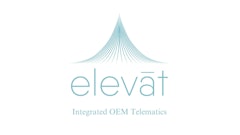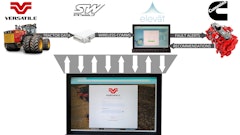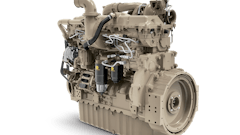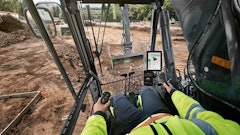Factory installed and fully integrated, Peterbilt’s new SmartLINQ remote diagnostics system provides customers with real-time, at-a-glance fleet health to maximize uptime, keep deliveries on schedule and manage service events, Peterbilt Motors Company announced during the Mid-America Trucking Show.
“SmartLINQ is the intelligent solution for getting the most productivity, profitability and performance from each Peterbilt equipped with this new technology,” says Darrin Siver, Peterbilt General Manager and PACCAR Vice President. “Utilizing Peterbilt’s new on-board diagnostics system, SmartLINQ remotely communicates truck health to the fleet manager, helping them plan and prioritize service and repairs at Peterbilt dealerships for maximum uptime while keeping deliveries on-time.”
Siver says SmartLINQ begins production in June and will be standard on all Peterbilts equipped with a PACCAR MX-13 engine. It includes a complimentary two-year subscription. SmartLINQ will be expanded to other truck systems and platforms in the months ahead.
“SmartLINQ can be customized to meet customers’ needs,” adds Siver. “For instance, the customer can choose to have the system communicate with one or more Peterbilt dealerships to create an action plan should a vehicle need quick attention. The dealership can be notified of the vehicle’s arrival – with preliminary diagnostics based on the triggered diagnostic codes – and have a service bay, technician and potentially needed parts at the ready.”
SmartLINQ In Action
Peterbilt Chief Engineer Scott Newhouse explains how SmartLINQ works.
When a diagnostic code is generated by the engine or aftertreatment system, it is analyzed and automatically communicated to the customer (as well as any Peterbilt dealerships the customer may assign to receive the notifications as well).
“When a diagnostic code is generated, the severity of the code is analyzed. There are three general areas the diagnostic codes will fall into: service advised; service immediately; and stop engine,” says Newhouse. “Diagnostic code notifications will be sent via e-mail to whomever the customer designates with all of the information a fleet manager needs to get a vehicle serviced quickly to maximize uptime. Or, in the event of more severe service issues, make arrangements to get a load hauled by another truck to keep deliveries on-time.”
Initially the system will monitor approximately 800 diagnostic codes.
E-mail notifications include:
- Vehicle information
- Diagnostic code and description
- Additional information such as if an engine derate is required
- Possible causes, including which items may be corrected by the operator
- Locations of the three nearest Peterbilt dealerships
- Recommended action
All vehicles equipped with SmartLINQ can also be monitored in real time through a web-based portal customized for the customer. The at-a-glance interface includes a map of North America with each unit represented by an icon color coded to vehicle health: green for no events; yellow for diagnostic codes that need attention soon; and red for diagnostic code events that require immediate action. There are also icons to indicate related information, such as Peterbilt dealer locations.
“In addition to the map display, fleet managers have access to a wealth of detailed, sortable data that is easily integrated with many other maintenance management platforms,” says Newhouse.
SmartLINQ-equipped trucks include a dedicated modem, antenna, access to the portal and the complimentary, two-year subscription. Additionally, SmartLINQ is compatible with any telematics system.
In-cab Diagnostics
SmartLINQ utilizes new in-cab diagnostic technology Peterbilt also debuted during the truck show. The expanded functionality, which communicates diagnostic information through the in-dash driver information center, will be standard on all Class 8 Peterbilt models beginning in the second quarter.
“Giving operators more information when diagnostic codes are present allows them to make smarter service choices – maximizing uptime, minimizing potential damage to the vehicle and helping keep deliveries on schedule,” says Siver. “It can help prevent unscheduled downtime and a possible roadside event.”
According to Newhouse, operators should take appropriate action when a diagnostic code is displayed. “It’s very intuitive. If the diagnostic code is potentially serious and a truck derate is necessary, a derate countdown timer will appear in the driver information display letting the operator know how much longer they can operate before getting to a service provider. It will also display what percentage of derate will occur within given timeframes.”





![Hd Hyundai Xite Transformation Booth Image[1]](https://img.oemoffhighway.com/files/base/acbm/ooh/image/2023/12/HD_Hyundai_Xite_Transformation_Booth_Image_1_.657a32d4218f2.png?auto=format%2Ccompress&fit=crop&h=135&q=70&rect=113%2C0%2C1600%2C900&w=240)





















